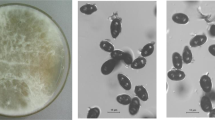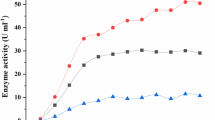Abstract
Polyporus sp. S133 fungi were selected based on their ability to degrade anthracene in liquid media. The degradation efficiency of anthracene increased by adding 0.5% Tween 80 to reach 71%; agitation at 120 rev/min increased the degradation to 92% after 30 days of incubation. Enzymes such as manganese peroxidase (MnP), lignin peroxidase (LiP), laccase, 1,2-dioxygenase and 2,3-dioxgenase were produced by Polyporus sp. S133 during incubation, and the highest enzyme activity was 182.3 U l−1 by 1,2-dioxygenase after 20 days of incubation. These results indicate that ligninolytic and dioxygenase enzymes secreted from Polyporus sp. S133 could play an important role in anthracene degradation efficiency. The metabolites detected through the degradation pathway were anthraquinone, phthalic acid, benzoic acid and catechol.




Similar content being viewed by others
References
Acevedo, F., Pizzul, L., Castillo, M. P., Cuevas, R., & Diez, M. C. (2011). Degradation of polycyclic aromatic hydrocarbons by the Chilean white-rot fungus Anthracophyllum discolor. Journal of Hazardous Materials, 185, 212–219.
Alexander, M. (1999). Biodegradation and bioremediation (2nd ed.). San Diego: Academic Press.
Bernardo, O., Santisteban, Y. S., & Filho, F. M. (2005). Agitation, aeration and shear stress as key factors in inulinase production by Kluyveromyces marxianu. Enzyme and Microbial Technology, 36, 717–724.
Choi, J., & Oris, J. T. (2003). Assessment of the toxicity of anthracene photo-modification products using the topminnow (Poeciliopsis lucida) hepatoma cell line (PLHC-1). Aquatic Toxicology, 65, 243–251.
Collina, E., Bestetti, G., Gennaro, P. D., Franzetti, A., Gugliersi, F., Lasagni, M., & Pitea, D. (2005). Naphthalene biodegradation kinetics in an aerobic slurry-phase bioreactor. Environment International, 31, 167–171.
Covino, S., Svobodova, K., Kresinova, Z., Petruccioli, M., Federici, F., D’Annibale, A., Cvancarova, M., & Cajthaml, T. (2010). In vivo and in vitro polycyclic aromatic hydrocarbons degradation by Lentinus (Panus) tigrinus CBS 577.79. Bioresource Technology, 101, 3004–3012.
D’Annibale, A., Quaratino, D., Federici, F., & Fenice, M. (2006). Effect of agitation and aeration on the reduction of pollutant load of olive mill wastewater by the white-rot fungus Panus tigrinus. Biochemical Engineering Journal, 29, 243–249.
Eibes, G., Chau, T. L., Feijoo, G., Moreira, M. T., & Lema, J. M. (2005). Complete degradation of anthracene by manganese peroxidase in organic solvent mixtures. Enzyme and Microbial Technology, 37, 365–372.
El-Enshasy, H., Kleine, J., & Rinas, U. (2006). Agitation effects on morphology and protein productive fractions of filamentous and pelleted growth forms of recombinant Aspergillus niger. Process Biochemistry, 41, 2103–2112.
Giraud, F., Guiraud, P., Kadri, M., Blake, G., & Steiman, R. (2001). Biodegradation of anthracene and fluoranthene by fungi isolated from an experimental constructed wetland for wastewater treatment. Water Resources, 35, 4126–4136.
Hadibarata, T., & Tachibana, S. (2010). Characteristic of phenantherene degradation by strain Polyporus sp. S133. Journal of Environmental Science, 22, 142–149.
Hadibarata, T., Tachibana, S., & Itoh, K. (2007). Biodegradation of phenanthrene by fungi screened from nature. Pakistan Journal of Biological Sciences, 10, 2535–2543.
Hadibarata, T., Tachibana, S., & Itoh, K. (2009). Biodegradation of chrysene, an aromatic hydrocarbon by Polyporus sp. S133 in liquid medium. Journal of Hazardous Materials, 164, 911–917.
Hadibarata, T., Tachibana, S., & Askari, M. (2011). Identification of metabolites from phenanthrene oxidation by phenoloxidases and dioxygenases of Polyporus sp. S133. Journal of Microbiology and Biotechnology, 21, 299–304.
Hadibarata, T., Yusoff, A. M., & Kristanti, R. A. (2011). Decolorization and metabolism of anthraquionone-type dye by laccase of white-rot fungi Polyporus sp. S133. Water, Air, & Soil Pollution.. doi:10.1007/s11270-011-0914-6.
Haritash, A. K., & Kaushik, C. P. (2009). Biodegradation aspects of polycyclic aromatic hydrocarbons (PAHs): a review. Journal of Hazardous Materials, 169, 1–15.
Jacques, R. J. S., Santos, E. C., Bento, F. M., Peralba, M. C. R., Selbach, P. A., Sa, E. L. S., & Camargo, F. A. O. (2005). Anthracene biodegradation by Pseudomonas sp. isolated from a petrochemical sludge landfarming site. International Biodeterioration & Biodegradation, 56, 143–150.
Kibbey, T. C. G., & Hayes, K. F. (2001). Effects of surfactant concentration and sorbed properties on the sorption and transport of ethoxylated non-ionic surfactant mixture. Journal of Contaminant Hydrology, 41, 1–22.
Kuwabara, M., Glen, J. K., Morgan, M. A., & gold, M. H. (1984). Separation and characterization of two extracellular H2O2-dependent oxidases from ligninolytic cultures of Phanaerochete chrysosporium. FEBS Letters, 169, 247–250.
Maertens, R. M., Bailey, J., & White, P. A. (2004). The mutagenic hazards of settled dust: a review. Mutation Research, 567, 401–425.
Manoli, E., & Samara, C. (2008). The removal of polycyclic aromatic hydrocarbons in the wastewater treatment process: experimental calculations and model predictions. Environmental Pollution, 151, 477–485.
Minussi, R. C., Pastore, G. M., & Duran, N. (2007). Laccase induction in fungi and laccase/N-OH mediator systems applied in paper mill effluent. Bioresource Technology, 98, 158–164.
Mohammadi, A., & Nasernejad, B. (2009). Enzymatic degradation of anthracene by the white rot fungus Phanerochaete chrysosporium immobilized on sugarcane bagasse. Journal of Hazardous Materials, 161, 534–537.
Nakazawa, T., & Nakawaza, A. (1970). Pyrocatechase (Pseudmonas). Methods in Enzymology, 17, 518–522.
Potin, O., Veignie, E., & Rafin, C. (2004). Biodegradation of polycyclic aromatic hydrocarbons (PAHs) by Cladosporium sphaerospermum isolated from aged PAH contaminated soil. FEMS Microbiology Ecology, 51, 71–78.
Ravindra, K., Sokhia, R., & Grieken, R. V. (2008). Atmospheric polycyclic aromatic hydrocarbons: source attribution, emission factors and regulation. Atmospheric Environment, 42, 2895–2921.
Stroud, J. L., Paton, G. I., & Semple, K. T. (2009). The effect of agitation on the biodegradation of hydrocarbon contaminants in soil slurries. Chemosphere, 77, 123–128.
Sutherland, J. B. (1992). Detoxification of polycyclic aromatic hydrocarbons by fungi. Journal of Industrial Microbiology, 9, 53–62.
Tien, M., & Kirk, T. K. (1984). Lignin-degradation enzyme from Phanaerochaete crysosporium. Purification, characterization and catalytic properties of a unique H2O2-requiring oxygenase. Proceeding of the National Academy of Science, 81, 2280–2284.
Valentin, L., Lu-Chau, T. A., Lopez, C., Feijoo, G., Moreira, M. T., & Lema, J. M. (2007). Biodegradation of dibenzothiophene, fluranthene, pyrene and chrysene in a soil slurry reactor by the white rot fungus Bjerkandera sp. BOS55. Process Biochemistry, 42, 641–648.
Wang, C., Sun, H., Li, J., Li, Y., & Zhang, Q. (2009). Enzyme activities during degradation of polycyclic aromatic hydrocarbons by white rot fungus Phanerochaete chrysosporium in soils. Chemosphere, 77, 733–738.
Wariishi, H., Valli, K., & Gold, M. H. (1992). Manganese (II) oxidation by mamganese peroxidase from the basidiomycete Phanerochaete chrysosporium-kinetic mechanism and role of chelators. Journal of Biological Chemistry, 267, 23688–23695.
Ye, J., Yin, H., Qiang, J., Peng, H., Qin, H., Zhang, N., & He, B. (2011). Biodegradation of anthracene by Aspergillus fumigatus. Journal of Hazardous Materials, 185, 174–181.
Zheng, X. J., Blais, J. F., Mercier, G., Bergeron, M., & Drogui, P. (2007). PAH removal from spiked municipal wastewater sewage sludge using biological, chemical and electrochemical treatments. Chemosphere, 68, 1143–1152.
Acknowledgements
A part of this research was financially supported by Research University Grant of Universiti Technologi Malaysia (vote no. QJ13000.7122.00 J31), which is gratefully acknowledged.
Author information
Authors and Affiliations
Corresponding author
Rights and permissions
About this article
Cite this article
Hadibarata, T., Khudhair, A.B. & Salim, M.R. Breakdown Products in the Metabolic Pathway of Anthracene Degradation by a Ligninolytic Fungus Polyporus sp. S133. Water Air Soil Pollut 223, 2201–2208 (2012). https://doi.org/10.1007/s11270-011-1016-1
Received:
Accepted:
Published:
Issue Date:
DOI: https://doi.org/10.1007/s11270-011-1016-1




